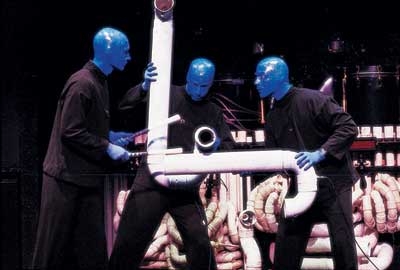Blue Men Exposed! Page 3
The Roar of the Greasepaint Blue Man Group took to multichannel in part because it allows their albums to be effective extensions of their stage shows. "Theatrically, we enjoy what the mix will do to an audience," says Wink, "to have it go from a really quiet close-up moment to suddenly shocking the listener with this wall of sound that comes out of nowhere."  The unique sounds of Blue Man's instruments, like the drumbone (above) can get lost in a stereo mix but come through loud and clear in multichannel DVD-Audio.
The unique sounds of Blue Man's instruments, like the drumbone (above) can get lost in a stereo mix but come through loud and clear in multichannel DVD-Audio.
Wanting their recordings to be true to the theater experience, the Group members have sometimes chafed at the medium's limitations. "We have Spinäl Tap syndrome a lot," says Stanton , "which is we want to go to 11. We have some songs that go from 10 dB to beyond the legal limit [in New York City ] of 105 dB and up to 120 or 130 dB, so we want to capture that on the recording."
"It's like with a classical album where you've got only a flute playing," says Goldman. "You turn up your system to hear the flute, and the next thing you know the rest of the orchestra comes in and blows the speakers out. Stereo playback has a much narrower range than live performance, but DVD-Audio gives you an actual 11."
To check out the boys' puckish sonic humor in action, cue up Audio 's first track, "Mandelgroove," which cruises along for o ver a minute with a mellow two-channel riff before exploding into all six speakers. That jolt isn't just some prank but a literal wakeup call, Blue Man's way of saying, "Surround matters."
For most musicians, recording is mainly about capturing a song, and the mix is almost an afterthought. But the blue men's heads are filled with surround sound possibilities from the get-go. Wink says, "Even during the writing process, we'll be going, 'That would be so cool if those were coming out of the surround speakers,' or 'We'll definitely have to start panning those back and forth.' That's way different from buying something like a Foreigner album where they went back how many decades later and figured out a surround mix."
And multichannel, not stereo, pretty much drives the recording process. "The 5.1-channel mix is part of the original mixing," says Perlmutter. "We don't come back to it later, after we do it in stereo."
- Log in or register to post comments



































































